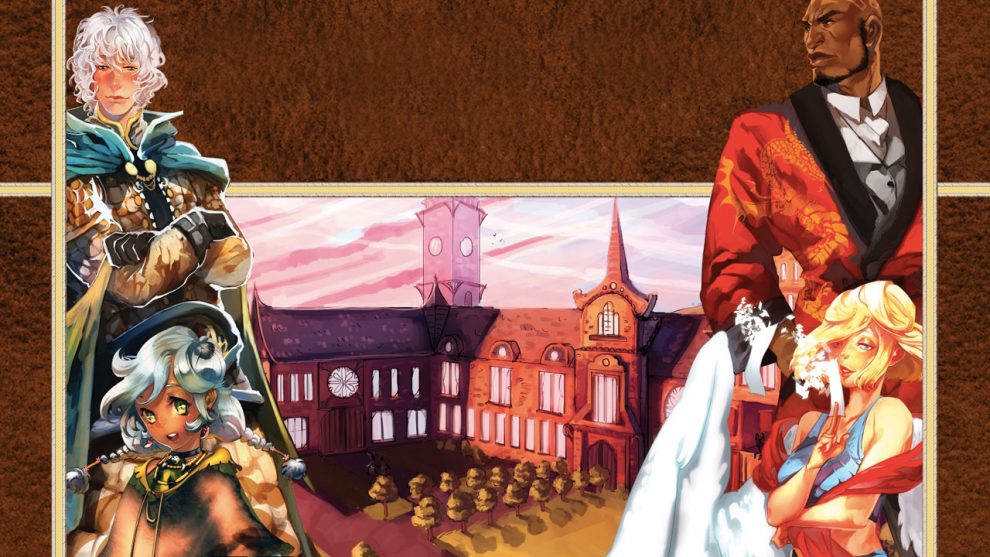Overview
Argent: The Consortium, created by Trey Chambers and published by Level 99 Games, takes place in the world of Indines – a fantasy world replete with a rich history and geography. Most of Level 99 Games’s games take place in this fictional universe, so there’s an underlying theme tying them all together. In the eastern edge of the realm lies the Oligarchy of Relecour which is where Argent University can be found.
Run like its own city state, the University is led by a Chancellor who is selected by popular vote by members of the University Community. This voting body is known as the Consortium. In Argent: the Consortium, the players are vying to become the new Chancellor by any means necessary – subterfuge, persuasion, and bribery. Each member of the Consortium has a different voting criteria and the players are trying to suss out just what their criteria are so that they can be certain they’re in a good spot to nab those precious votes. This is accomplished through a process of worker placement and resource management. However, there is a twist. Different workers have different abilities and it’s going to require strategy and cunning to use their abilities efficiently and effectively if you hope to win the game.
In the end, it’s the votes that count. If you manage to scoop up more votes than your opponents, you will be chosen as the new Chancellor of Argent University.
Meeple Mountain was provided with a review copy of this game by the publisher.
Components
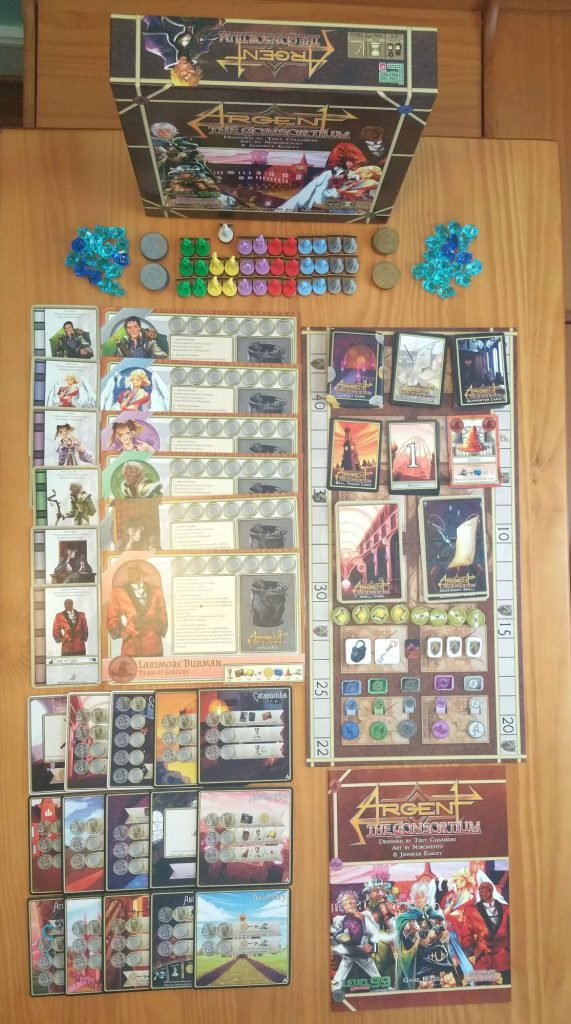
Argent: the Consortium is jam packed with components and weighs in at almost 5 pounds. Opening the box, the first thing that will probably catch your eye are the minis. These come in several different colors and styles (7 to be exact). Each of these minis also comes with an accompanying base. In addition to these plastic pieces are an assortment of chunky mana crystals and plastic coins. The crystals are large and have a nice tactile feel about them. While the plastic coins are obviously much better than cardboard currency, one almost wishes that they were made of metal instead. Oh well.
Digging further into the box, you will find a plethora of various tokens and other pieces – control tokens (called Loyalty Badges), Marks (used to peek at voter requirements), Merit Badge tokens, Influence tokens, Wisdom and Intelligence tokens, a first player marker, as well as a few other markers that come into play with various rooms. And speaking of rooms, there are 15 double-sided tiles that represent the various rooms in the University as well. In addition to the previously listed items are a selection of cards of various types – spell cards, supporter cards, vault cards, bell tower cards, consortium voter cards, round cards, and mage reference cards – each serving specific functions throughout the course of the game. These are all printed on the same cardstock as the double-sided character sheets are.
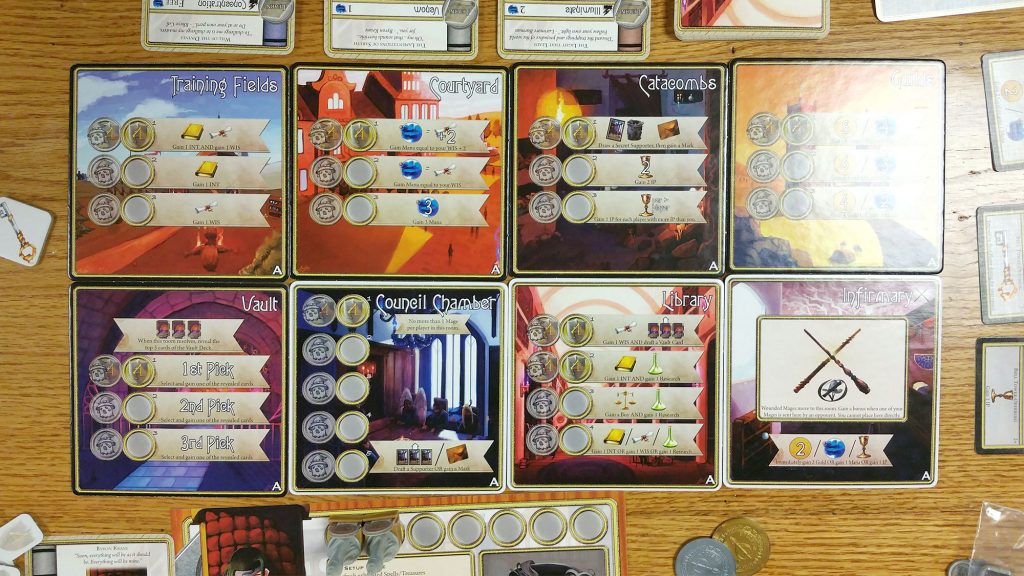
The only other items of note inside the box are the large Consortium board and the rule book. The Consortium board is where the voter cards will reside during the game and it also contains an area for the players to keep track of their influence. The rule book that we were provided, while incredibly well designed and well written does suffer from one glaring flaw. At the beginning of the rule book is included a QR Code so that you can ostensibly skip the rules and watch an instructional video instead. Following this QR code leads to an inactive page with nothing on it. Trying to manually browse to the website provided also returns nothing. However, this appears to have been resolved in the new version of the game. Overall, the component quality in the game is top notch; I was impressed before I even knew how to play. It’s too bad the insert for this game is terrible. It feels like they had a few leftover from a previous game and decided to just go ahead and try to use them all up. It’s quite a feat to get everything to fit into the box without the box lid bowing out.
If you’ve already got a good feel for how the game is played and just want to know what I think about the game, feel free to skip ahead to the Thoughts section of this review. If you’re curious as to how the game is actually played, then read on. I’m going to try to give you a feel for it without going into a lot of nitty gritty detail.
Setup
The set up for this game takes a while as there’s just a lot going on. Firstly, each player chooses a character, selects a side of the character sheet to play, and gathers up all of the items associated with whatever character they’ve chosen. Next, the Consortium board is laid out and seeded with Consortium voter cards. Two of these will always be face up in every game. The others are randomly selected and will remain face down. At the beginning of the game, each player is allowed to place one of their Marks on a single voter card and then peek at it to determine what that voter is looking for at game’s end (most money, most mana, second most influence, etc.). The needs and desires of these voters dictate the strategy for the rest of the game.

After seeding the Consortium board, it’s time to build the university. The rule book offers suggestions for various layouts. The players can follow those suggestions or set up everything randomly if they so choose. Not every tile will be used to create the layout of the University, but there are a few that will be included with every layout (Council Chamber, Infirmary, and Library). After the University tiles have been laid out, the spell card, the vault card, and the supporters card displays are laid out alongside it according to the rule book. The bell tower cards are arranged close by along with the round cards and the mage reference cards.
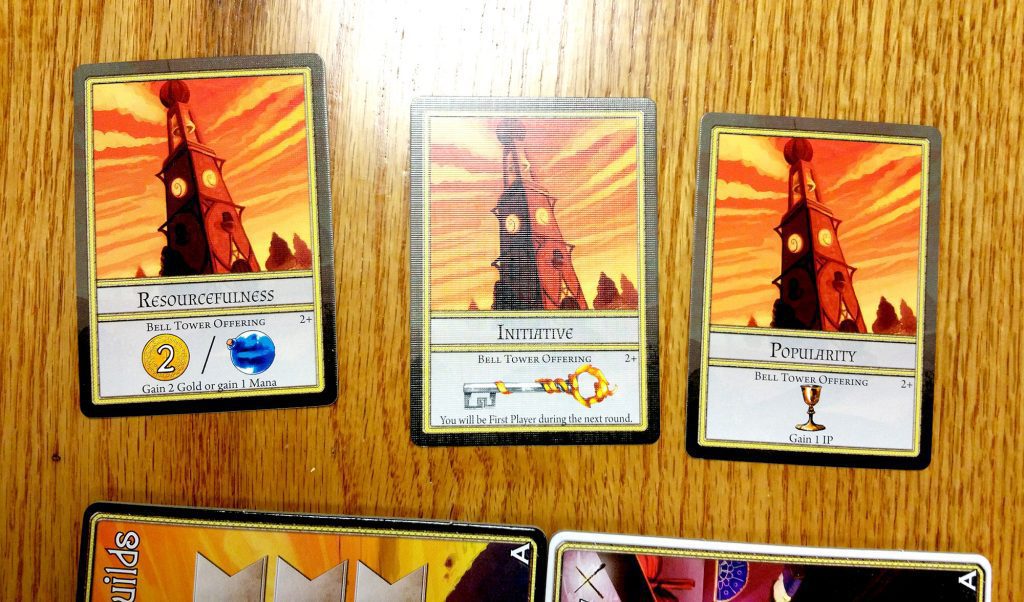
Next, the mage minis are set aside (arranged by type) along with the supplies of money, mana, and the other tokens. Each player will begin with a certain amount of these tokens and a certain amount of money. They will also begin with a couple of mages of a specific type which is determined by the character that they elected to play as. A starting player is chosen and then the players will draft a few more mages from the remaining supply. These will be their workforce for the remainder of the game. Now you’re ready to begin playing.
Anatomy of a Round
Argent: the Consortium is broken up over a series of 5 rounds. Each round is divided into several phases: setup, errands, and resolution. During the setup phase, the players’ spells are refreshed along with the vault, spells, and supporters decks. Then the errands phase begins. This phase consists of a varied number of turns. In this phase, the players take turns assigning their mages to the various rooms in the University. Each player can optionally perform one Fast Action (a specific type of action provided by some cards) followed by a mandatory regular action. If the player chooses not to take an action, they can take one of the bell tower cards instead and gain whatever benefits it provides. Or, instead of taking a bell tower card, the players can use any vault, spell, or supporter cards that they may have during this phase, but they are limited to only using one card per turn. As soon as the last bell tower card is taken, the round comes to an end and the resolution phase begins.

Beginning with the top left room and moving left to right, the rooms are assessed from top to bottom. As each mage is removed and returned to its owner, the mage’s owner gains whatever benefit is provided by the room tile or performs whichever action the room tile dictates that they perform. This process of removing the mages and performing actions continues until all mages have been removed and returned to their owners. Then the next round begins. To signify the round change, the topmost round card will be removed so that the current round number is displayed.
The Mages
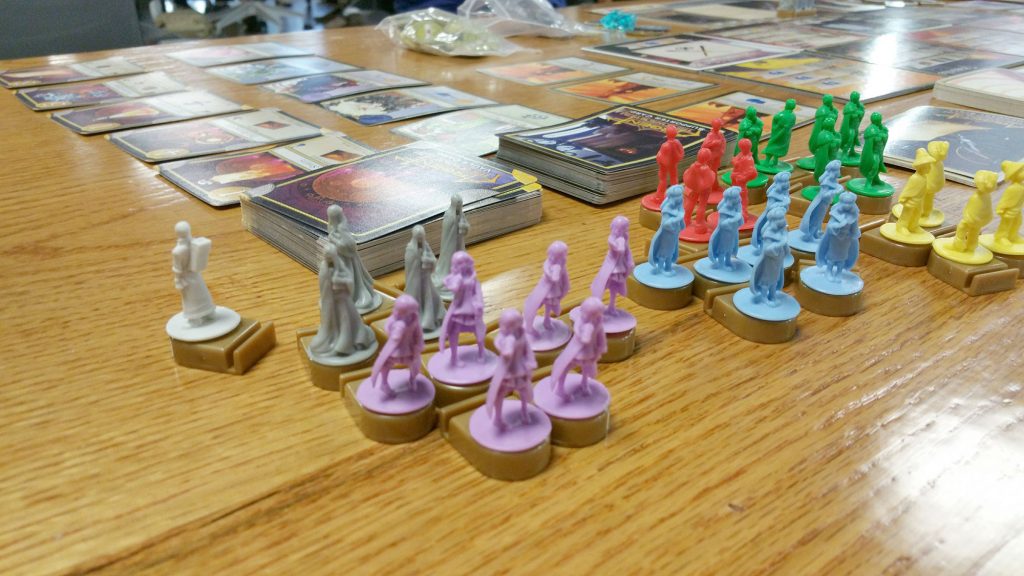
Argent: the Consortium is a pretty standard worker placement game with one exception: each of the different mages has a unique ability that makes it useful in specific situations. Each of the mage reference cards is double-sided. Depending on the side you choose to use, these cards will define the ability that a particular color of mage possesses during the game. Here are the colors and their associated abilities for the basic game:
Red – when placing this mage into a spot, the player can pay 1 mana to wound the mage that is in that spot. Wounded mages are sent to the Infirmary where they immediately earn their owners some kind of benefit.
Green – Immune to being wounded.
Blue – Cannot be affected by spells
Gray – Can be placed immediately after casting a spell. If coupled with a Fast Action, this could mean performing three actions in a single turn.
Purple – Can be placed as a Fast Action
Neutral – No special abilities. These are just generic workers.
Spell, Supporter, and Vault Cards

During the resolution phase, the various room tiles will award the players with cards from one of these three decks. Each type of card has value in certain situations. Spells are generally useful at any time by allowing players to steal mana from other players or wound other players’ mages, for example, while vault cards and supporter cards aren’t quite as universally useful. Vault cards are typically items that the player will use up to gain some sort of temporary benefit, but some of the vault cards stick around and provide valuable, long-lasting benefits. Supporters also provide some kind of one-time benefit but, more importantly, each supporter is affiliated with a specific school of magic (green, blue, red, grey, etc.) and this can be useful when assessing the Consortium voter cards at the end of the game.
The Consortium Board and Influence Track

The Consortium board is where the Consortium voter cards live. These are all face down at the beginning of the game with the exception of two which are always public knowledge. These cards dictate the scoring conditions that will win the players votes. A player learns each member’s scoring condition by placing one of their marks on the card and taking a peek. They can peek at any card that holds one of their marks whenever they like. Above the Consortium card area lies the Influence track. This is important for two reasons. First, influence points break ties whenever ties appear in the game. Secondly, each time a player earns 7 Influence points, they get to take a merit badge from the supply and add it to their playing area. These merit badges allow players to take actions on the room tiles that they normally couldn’t take.
Worker Placement
No two workers may ever share the same space. This is why being clever with your mage placement is of key importance. Additionally, some areas of the board require you to use a merit badge in order to use the space’s ability during the resolution phase. There are also some actions that can be “shadowed” which is an ability, provided by various cards, that allows a character to place one of their mages into a secondary slot at specific locations.
End Game and Scoring
The game ends at the end of the fifth round. At this point, all of the Consortium cards are flipped over and assessed one at a time. Whoever has the most votes at the end of the game wins. If there’s a tie, the person that has accumulated the most influence wins.
Thoughts
Let’s not mince words here. Argent: the Consortium (A:tC) is pretty fantastic. I am absolutely blown away by it every time that I get it to the table. There’s so much depth and so much replayability that I just can’t get enough of it.
To begin with, I’m a sucker for a good worker placement game. It’s probably my favorite game mechanic ever. A:tC makes very good use of it here. A:tC manages to take this tried and true mechanic and make it feel like something new and unique. Most other worker placement games treat your workers the same when they’re placed onto the board. They’re just there to determine which resources you’re going to receive or which actions you’re going to take. Here, though, you’re not guaranteed anything because of the different mage powers. If you’re not careful, your opponent could place a worker down that can easily negate whatever it is you’ve just done. So, this game forces you to be clever with who you put out there, where you put them, and when. If you try to play it too safe, you could wind up having to finish out the round with only one or two workers on the board. Playing a more aggressive strategy, though, could see you finishing the round with most of your workers in the Infirmary which is definitely better than nothing at all, but only just barely. I love the almost chess-like quality of this aspect of the game.
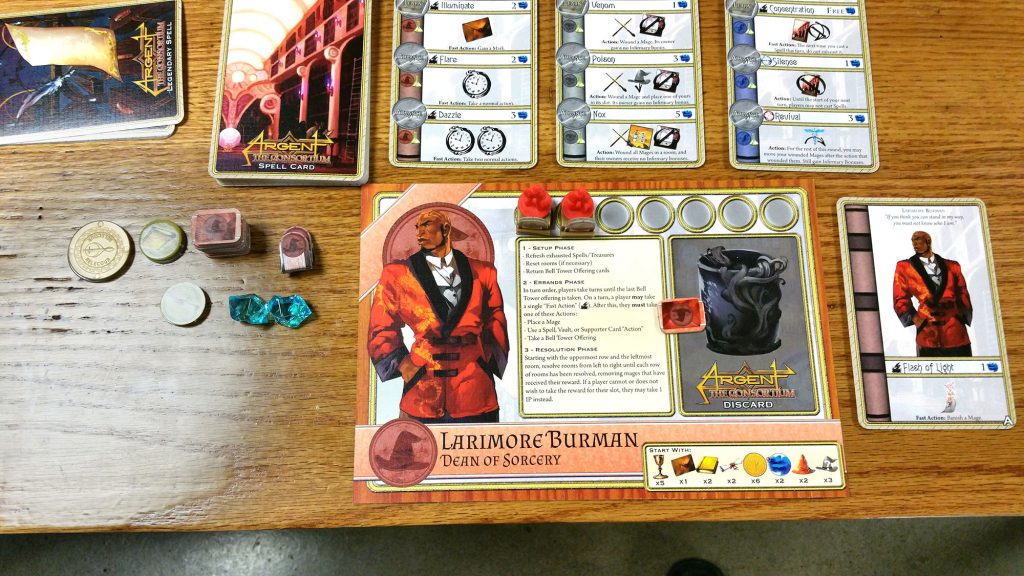
Then there are the hidden agendas. Each of the voters is looking for something different and a huge part of the game is trying to figure out what those things are so that you’ll win that person’s vote. This puts the players in a position of having to choose between trying to laser focus on one specific aspect of the game or trying to diversify to get a little bit of everything. Oftentimes the voters are looking for things that might overlap. One voter might be looking for whoever has the most spells, while another is looking for whoever has the most cards of a specific magic school, while another might be looking at who has the most supporters of a specific type.
In such a situation, a strategy of focusing on purchasing every spell that you can while grabbing up all the supporter cards of a particular school that you see could pay off in the end game and earn you those votes. However, a laser focused strategy such as this could just as easily burn you if your opponents figure out what you’re doing and try wound your mages off of the board at every opportunity. This is just one way that it could play out. Some players might choose to forgo using their marks at all and just cross their fingers and hope they’ve grabbed up whatever is needed for them to win by the end of the game. While it’s definitely not the smartest strategy, it is a viable one. Less time spent gathering up marks is more time spent gathering up something else.
Another aspect of Argent: the Consortium that really impresses me is the overall quality of the game. All of the pieces are extremely well produced. The miniatures look fantastic. The cardboard is nice and thick. The cards all have linen finishes. Heck, even the rule book has a linen finish. There’s nothing about this game that feels cheaply produced. You are guaranteed to feel like you’ve gotten your money’s worth.

The only thing that doesn’t impress me, though, is probably the one thing that impresses most other people. That is – the artwork. I’m just not a big fan of it. I love me some manga and anime. I’m not adverse to a board game being illustrated in that way. Taken piece by piece, the artwork in this game is pretty stellar and Nokomento and Jennifer Easley have both done a very good job. However, when put all together, everything just sort of clashes. One card looks dark and foreboding while the next looks like bubblegum pop. One character looks sleek, angular, and ultra-realistic while the next has massive almond shaped eyes and exaggerated features. It just doesn’t feel very cohesive to me and, to be quite honest, were this game not provided to me for review, the artwork alone would have made me lose interest in it before I’d even learned anything about it. And that would have been to my detriment because now I can’t imagine my collection without Argent: the Consortium in it. I like it so much so that I’ve put my money where my mouth is and I am eagerly awaiting my Argent: the Consortium second edition upgrade kit even as I write this.
If Argent: the Consortium isn’t on your game shelf, you don’t know what you’re missing. I highly recommend you go fix that now.


